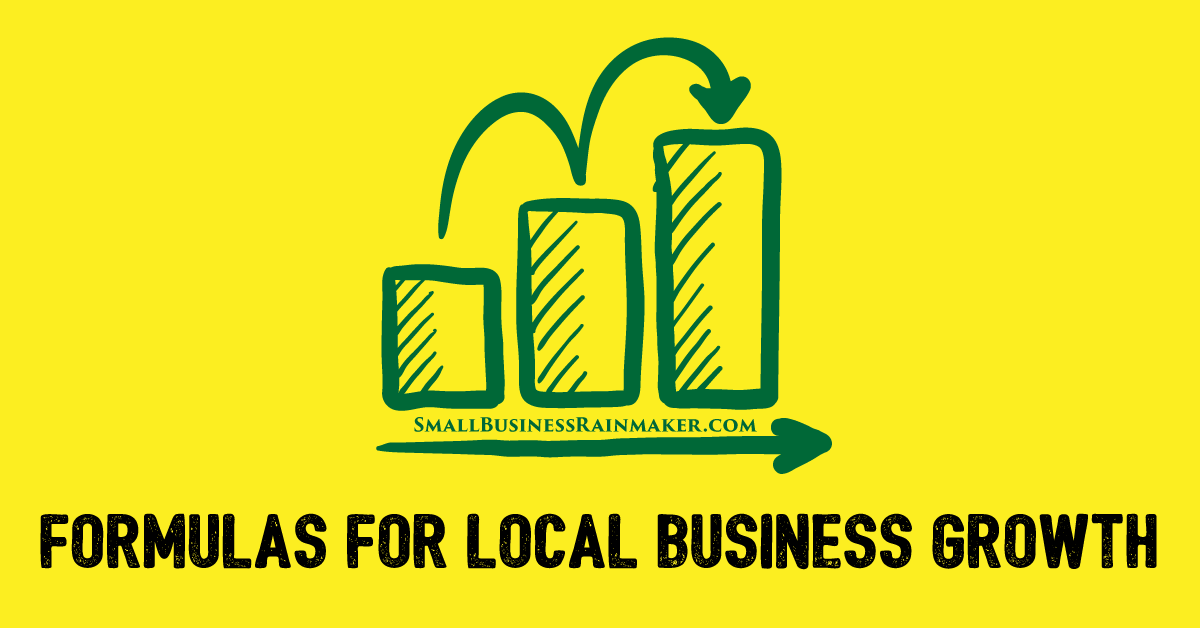
No doubt about it, sales is the make-or-break lifeblood of any business. Without sales growth, the business goes under.
You may be experiencing a drop in sales these days, due to COVID-19 or other reasons. But there could be other factors impacting your sales – your marketing strategy, management issues, customer service quality, or the product or service itself.
Formulate a sales growth strategy, using diverse methods, taking into account every aspect of the sales process. Be willing to try things you haven't before.
Sales Growth Tips for Local Small Businesses
I’ve pulled together 14 articles that take a close look at various aspects of the sales process, with tips and strategies for sales growth. You'll find links to all the articles in each section where you can read more.
Some of these strategies are free. Some take advantage of information already at your fingertips. Some require an investment of funds. All of them require you to spend some time understanding and implementing them.
10 Surprising Things That Explain a Decline in Sales

Let's start our investigation of sales growth issues with a look at what may be causing your sales problems. You may not even be aware that these things are going on in your organization. Or, you may just be overlooking them, hoping they’ll go away.
Independent business consultant Jen McKenzie lays out some easily overlooked reasons you may be experiencing a decline in sales. Check out the article to get solutions:
- Not paying attention to the customer’s needs
- Poor working conditions
- The product or service has no Unique Value Proposition (UVP)
- Mismanagement or leadership failure
- Scaling when you're not yet ready
- Marketing and sales are not aligned
- Nor organic web traffic to support sales
- Not paying attention to the competitors
- Poorly trained staff
- Disregarding customer loyalty
How a SWOT Analysis Can Help You Increase Sales
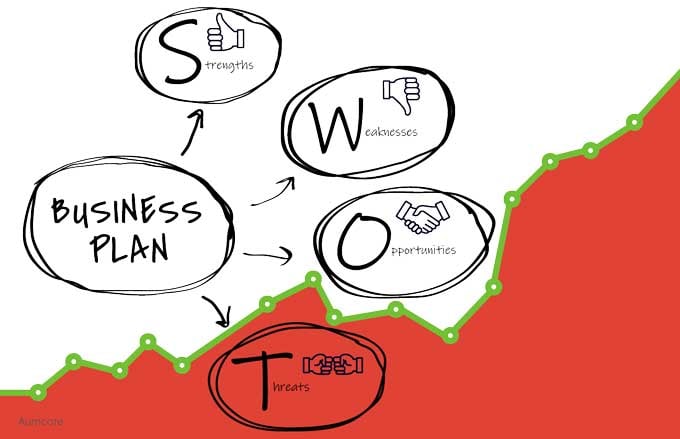
Time to do some digging into how your sales process stacks up right now.
Conducting a SWOT (Strengths, Weaknesses, Opportunities and Threats) analysis can help you and your team make sound business decisions that lead to a positive sales growth rate. The analysis consists of delving into various areas of your business.
Therese Palmere, a consultant for a digital marketing agency, offers a number of questions to ask yourself, as part of your SWOT analysis. You'll assess your findings, make adjustments to business operations, and introduce a plan of action addressing any issues:
Strengths
- What does our team do best?
- Why does our team do this best?
- What makes our business unique?
- How do people outside of our organization describe our strengths?
- What is our company’s greatest achievement to date?
Weaknesses
- What does our team do worst?
- Why do we feel that way?
- What are the disadvantages we have as an organization?
- What feedback have we received from colleagues and customers regarding what we need to work on?
- What do our employees need more training in?
Opportunities
- How do we take the negative feedback we’ve had and use it in a positive manner?
- Where do our employees need more support?
- In what ways can our company take advantage of the changes affecting our industry?
- What new business ventures can our team afford to take on within the next 6 months?
- Is there an industry need we can meet that we currently are not?
Threats
- What obstacles do we face in production, sales, workplace environment, and other areas of our company?
- Do any of our current weaknesses negatively impact our business to the point where we may not meet our goals?
- What business practices do we employ that may hinder our success in the future?
- Do our products and services provide the same quality and satisfaction as our competitors?
- What changes in our industry should we be wary of?
Mass Marketing vs. Target Marketing: Which Works Better?

It may seem counter-intuitive, but targeting is the way to go. Mass marketing requires being able to understand, reach and attract a wide audience. Unless you're a massive organization like Amazon, it's unlikely you'll have the resources to capture the attention of virtually everyone.
Target marketing focuses on a select audience and ensures your marketing dollars are well-spent.
Marketing content specialist Mike Austin says:
"Mass marketing involves advertising products or brands to a wide variety of audiences. The goal is to reach as many people as possible, regardless of whether they are interested or not. Popular examples are TV and radio advertising.
In contrast, target marketing is a strategy geared towards more specific audiences. Here, you focus all your marketing efforts on the audience or segments that are more likely to respond.
There’s no doubt that target marketing requires more work. You need to do extensive research to understand your target audience. But the best part is that you can promote your product or service to the right audience at the right time, which leads to more conversions."
Among the benefits of target marketing for small business, he lists:
- Promotes effective advertising
- It’s a cost-effective approach
- Lets you create personalized content
- Helps you build relationships with your customers
- The results are measurable
The Importance of Market Research for Continued Sales Growth

Moving beyond your SWOT analysis and marketing approach, market research and analysis are critical for any business to grow, thrive and stay ahead of the competition.
Market research survey designer Bhavika Sharma describes 6 compelling reasons why market research is so important:
1 - Helps develop better business strategies
Here are some areas to conduct market research:
- Advertising and media usage
- Product development, pricing and positioning
- Target customer communications
- Brand placement
- Diversification
- Launch time
- Distribution and logistics
- Business progress evaluation
2 - Helps identify potential business opportunities
With accurate market survey analyses, you can follow current industry trends, forecast pitfalls, and reach out to target markets with better offerings.
3 - Gives a better understanding of consumer preferences and needs
Creating a great customer experience is key to positive sales growth. There are several online survey tools that allow you to customize your market survey to:
- Identify decision-making triggers
- Understand customer needs
- Study purchase patterns and behaviors
- Discover pain points
4 - Delivers accurate insights about your competitors and their marketing approach
If you want to step up your game and grab back your customers who went to the competition, you need to do a market survey. An engaging and conversational market survey will help you identify key players, assess their approach, and find the gaps in their strategies.
5 - Lowers business risks and reduces losses
Market surveys help identify issues before they blow out of proportion, predict pitfalls that can put your business in trouble, and generate insights that help you anticipate change and stay relevant.
6 - Helps test products before market launch
Before you expose your product to the market, make sure you test it out on your target audience. Product testing will save you from incurring additional expenses re-jigging to improve the product and also save you from launching a bad product into the market.
How to Validate Your Business Idea Quickly and at No Cost

As noted above, launching a sure-fire new business requires research and business idea validation.
Online business expert Fran Canete advises:
"The faster you can test your idea and show that it is profitable or not, the faster you will speed up the process to start developing the project. Or, more importantly, in the case it is not feasible, you can quickly drop out and move on to your next project without losing your money on the way. As they say, 'fail fast, learn faster.'"
He offers three questions to ask yourself before diving headfirst into putting your idea into action:
- How many people have the problem that you are trying to solve?
- Are they willing to pay for a solution to their problem?
- Can they actually pay for it?
He further suggests asking experts as well as potential customers their opinions to get valuable free feedback. To get this all-important feedback from potential customers, use the three content publishing opportunities available on LinkedIn:
LinkedIn Pulse . . . LinkedIn Groups . . . LinkedIn Updates
Keep track of comments and other reactions you received for your posts on these three LinkedIn places, and reach out to them to see if they'll answer a few of your research questions.
How to Use Data Mining Information You Already Have

If you're like most smart small business owners, all along you've been collecting data on your customers and their behavior patterns. In the digital era, it's easier than ever to do this.
When you understand your customers' intent and buying behavior, you can improve your conversion rate and attract more of the right kinds of customers.
Peta Daniels, a seasoned CX strategist, lays out five easy data metrics to build leads and grow sales:
1. Interest intent
To determine what your customers are searching for, run a Google Ads campaign and collect the data from the keyword search query report. That provides all of the keywords used to trigger the keywords in your campaign. Then use those keywords to build out your web and sales copy and other campaigns.
2. Browsing location
Pinpoint precisely where your best customers come from. Then target prospects based on postcodes, city names or regions.
3. Latency
Set up your Google Analytics tracking so that you can see how long the time period is between when customers search for your product or service and when they buy. You can then get data to help you understand factors influencing their buying decisions.
4. Demographics
Configure your analytics to provide customer demographics showing who purchases your products or services, and their intent. You can then improve your campaign targeting to hit the exact audience that will be interested in your offerings.
5. Engagement metrics
Analyze your website engagement metrics – bounce rate, number of pages viewed, and conversion data – to identify where you can make improvements.
How Good Product Documentation Can Improve Sales in 30 Days
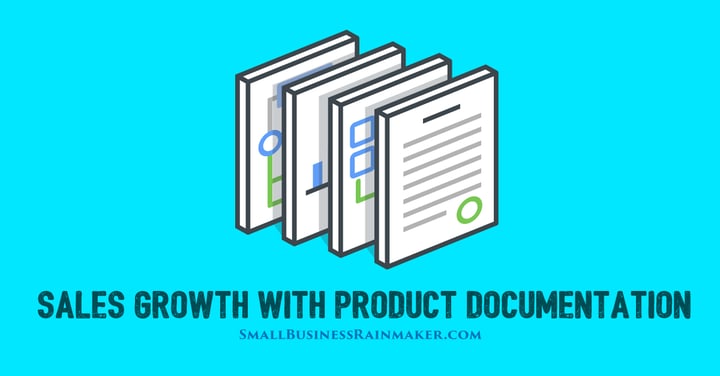
Most small businesses stick to the tried and true, proven offline sales methods, whether they're selling offline or online. They play it safe and resist (or fear) trying innovative or different methods they're not familiar with.
Brayn Wills, a knowledge management manager, has a better idea:
"Product documentation, the most undervalued weapon in the sales arsenal, has the potential to fill sales pipelines within no time. It is also what makes a next-gen salesperson the purple cow in a herd of black and white. In a world where smart sales cycles and shrewd headlines dominate sales strategies, product documentation has turned out to be a secret weapon for the ideal salesperson."
He describes how an impeccable product document can make life easier for your sales reps:
Functions as a product demo
Essentially walking prospects through the entire workflow of a product or service, it handholds them with the help of intuitive descriptions and screenshots, while explaining the capabilities or limits of a product. This enables sales reps to deliver a sneak peek into the product in action.
Warms up leads
Having much higher authority than a marketing brochure, product documentation's purpose is to assist customers, not to convince prospects. It becomes a source of critical pre-sales market research for managers.
Provides cross-selling and upselling opportunities
While pitching the functioning of product A in its product documentation, another savvy approach can be introducing the benefits of a related product B. Apart from working as a reliable SEO tactic, product documentation also provides information on how to use product combos and address specific user concerns.
Builds better brand authority
Establishing a reliable brand was once a resource-intensive media strategy that required years of market intervention. Today, a digital company can do this with a robust technological infrastructure and reliable product documentation.
Boosts customer retention
A well-structured product document enables your customers to explore features that deliver value and helps them realize the benefits of these features. This encourages recurring revenues from existing customers and reduces churn.
Increase Product Quality to Build Sales Growth

Product quality has an enormous impact on long term sales growth and profitability. Although improving quality is not an easy fix, the effort will increase sales and reduce costs.
According to cyber security, quality management, and compliance content creator Neb Ciric:
"Quality is concerned with satisfying a set of predetermined specifications. On the other hand, quality can be all about satisfying your customers."
He advises embedding product quality in routine processes and making it intrinsic to performance and daily operations:
Build a solid product strategy
To stand out in a sea of countless new products, you need to devise a brilliant product strategy. You will have to create something unique. Find inspiration by talking to your users and prospects.
Then think about product goals. The goals will serve as KPIs and by prioritizing them you will be able to create plans for product functionality, features, etc. Knowing your goals, you'll be able to prioritize your product roadmap.
Implement a Quality Management System (QMS)
A quality management system (QMS) such as ISO 9001 is a set of internal rules that will determine how a business will create and deliver their products or services. Such a system allows you to audit your processes yourself along with a certification body.
By complying with the QMS standard, you improve your business’s credibility and image but most importantly, you will enhance customer satisfaction levels.
Make quality part of your company culture
Your entire team needs to embrace making product quality a priority. Get everyone on board with your vision of quality.
Bring your employees in on the development process. Their input can be extremely valuable, and their involvement will help keep them on track with quality.
Perform product and market testing
You need to analyze and test your product before the launch to correct errors, adjust features, and make other changes to be sure it will meet the needs and requirements of your customers.
Beta testing will help you see how your product performs in the real world vs. in a controlled environment.
5 Tips to Reduce Your Facebook Advertising Costs

Facebook is an essential advertising platform for small business, and especially for local business.
With more than 2 billion active users, lots of your target customers are hanging out there, influenced and motivated by advertising.
Marketing strategist Kevin Urrutia notes five things every small business should do to avoid budget-depleting Facebook ad mistakes:
1. Make clear objectives
- Set clear goals as a group: When you discuss the campaign and goals with your team, you are more likely to reach your desired goals.
- Come up with an action plan: Do not just set goals. Design an action plan that will define the process you want to follow and how you will achieve it.
- Set KPIs: Regularly track your key performance indicators to maximize your campaign.
2. Know your audience
We looked at target marketing a little earlier here. On Facebook, advertisers can choose groups of people to show their ads to. So you'll need to create a buyer's persona in plenty of detail, on which to base your targeting.
Here are some questions to ask in your research:
- What do your ideal customers search on search engines?
- What apps do they use?
- What kind of influencers do they follow?
- What pages do they “like” on Facebook?
- What type of blogs do they read?
- Where do they hang out on Reddit?
- What competitors are they buying from?
3. Use Facebook Pixel
Pixel is a way to use analytics to track interactions and conversions for your ad and landing page and is used in three ways:
- Create a custom audience for your site so that you can re-market to them.
- Optimize your ads for conversions.
- Track conversions on your event page or website, then attribute them to your ads.
4. Refresh campaigns
Keep your target customers' interest by changing things up regularly:
- Revise your content or copy.
- Edit your images.
- Rotate your ad formats.
5. Do A/B testing
Try out different versions of your campaign and learn what will make your brand resonate more with your audience. This gives you a baseline to measure from.
How to Use Digital Coupons to Propel Sales Growth
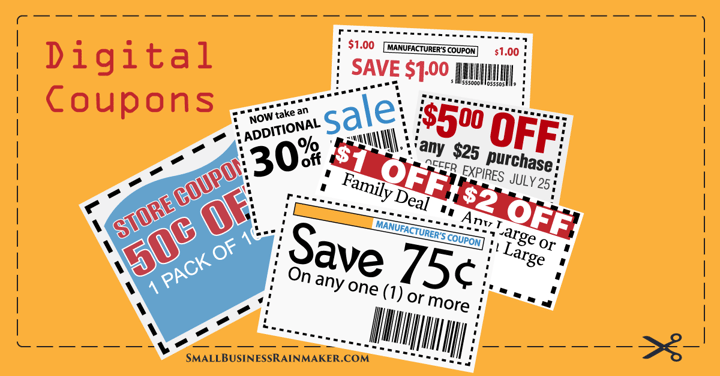
Paper coupons hit the market in the late 1880s and ultimately transformed the retail industry. Digital coupons are now pervasive and often used.
Content marketer Marielle Lea says digital coupons serve several purposes. They help businesses:
- Land new customers
- Build customer loyalty
- Promote new products
- Get market research
She suggests ways to create and use digital coupons to drive sales growth.
Create the perfect digital coupon with:
- A clear expiration date to tap into the scarcity principle
- A catchy Call-to-Action (CTA) to promote a purchase behavior
- Digital tracking codes to provide helpful consumer data
Distribute your coupons via specific channels for the best results:
- 90% of millennials say they share deals with their friends and family, and 43% of those say they share via social media.
- Receiving daily deals is the #1 reason people subscribe to marketing emails.
- 61% of smartphone users subscribe to mobile messaging for deals and incentives.
SaaS Industry Marketing Tricks Every Small Business Can Benefit From

You may not be familiar with SaaS (subscription-based software as a service), but you're probably using some kind of SaaS product regularly.
Digital marketing consultant Alex Brian describes some SaaS industry marketing tricks you can incorporate into your business growth strategy . . . even if you're not offering subscription-based products:
Offer free trials
Give customers the option to test drive your product or service for free, for a short time, so they can determine whether it's useful for them. Once the trial is over, they'll have to purchase a subscription to the product or service.
The scarcity effect
Create a sense of scarcity, and therefore an urgency to purchase. Phrases like “limited time offer,” “offer expires within 2 weeks,” or “only 2 slots left” work just fine. The fear of missing out compels a customer to make a decision on the spot.
Ask for testimonials
SaaS companies are always collecting user information through questionnaires and brief surveys, and posting this feedback as testimonials. Potential customers will trust the words of other customers who have genuinely used their product. Shoot your customers a quick follow-up email asking them to rate your services. If they give you a good rating, you can even ask them to write a testimonial. You can increase your odds of getting a great testimonial by pre-writing it for them and simply getting them to sign off on it.
Offer great customer support
What kind of customer support you offer depends on your business model. If you have a self-service business, it will be enough to just offer chat and email support. On the other hand, if you are an enterprise business, then you are going to need a live chat or some one-on-one solution.
Include app integrations
Although it requires research, integrating with popular apps is a great way to spread the word about your business. Start by finding out which apps your competitors use.
Churn
SaaS businesses mostly rely on subscriptions and renewals, so they focus heavily on drop-off or lost customers (known as churn) and improving retention. Acquiring new customers is much more expensive than keeping existing ones. Find ways to delight your customers and keep them coming back.
Is Same Day Delivery Possible for Every Business?
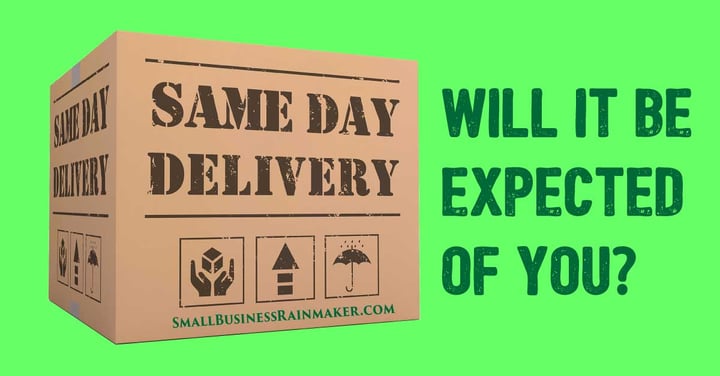
Are you keeping pace with your big and small business competitors who offer same day delivery of their products?
This trend has a foothold in the online market these days. With so many of the products we want available for same day delivery, we've become predisposed to expecting every business to offer it. And, we're willing to pay more to get things sooner.
A content writer for a small business market research services company, Gracie Myers notes some of the challenges facing small businesses looking to offer same day deliveries:
- Processes need to be created to accommodate same-day delivery.
- Small businesses must ensure that it’s possible to fulfill orders in their local area.
- Data must be streamlined in a way so that when customers place an order, the system can automatically assign a person to carry through with the actual delivery. This system must be automated.
- One-Day delivery service is expensive so it must be priced accordingly.
- Inventory must be accurate. Most businesses struggle with inaccurate inventory, but for a one-day delivery service to work, a business must constantly update their inventory.
Understanding International Negotiation Styles

Doing business with customers who come from the same country, with a similar cultural background, comes naturally to most of us. We share the same kind of social graces and customs.
Even so, Small Business Rainmaker founder Andre Palko advises being mindful of the five main styles of negotiation and conflict resolution:
- Competing
- Accommodating
- Avoiding
- Compromising
- Collaborating
Understanding our own style helps us adapt to others' styles.
If your business goes global, as Andre suggests:
"You might find yourself, as I did, venturing into international waters to negotiate with overseas suppliers, manufacturers, and shipping partners.
This adds a new level of complexity to your negotiations that goes far beyond differing negotiation styles. Working internationally, you’ll face important cultural differences that also affect how your negotiation tactics will work.”
Some elements that will differ among cultures include views on such things as:
- Authority
- Individualism versus collectivism
- Masculinity and femininity
- Uncertainty or ambiguity
- Time frames
- Definition of quality of life
As you can see, the mix of negotiation style plus cultural differences adds up to quite few variations on what might, at home, be a simple negotiation.
Take a look at the infographic in this negotiation article to get a handle on negotiation styles for these countries:
- United States
- Canada
- Mexico
- Brazil
- South Africa
- United Kingdom
- France
- India
- China
- Japan
For Introverted Small Business Owners with Phone Call Anxiety

Often confused with shyness, introversion is a personality type characterized by "a preference for the inner life of the mind over the outer world of other people," according to Psychology Today. They state further:
"Introverts do not fear or dislike others, and they are neither shy nor plagued by loneliness. A crowded cocktail party may be torture for introverts, but they enjoy one-on-one engagement in calm environments, which is more suited to the make-up of their nervous system."
Introverts can find social interactions (including phone calls) tiring, draining and even anxiety-inducing. They may postpone or avoid making necessary phone calls, thereby leading to a decline in sales.
Christina Attrah, copywriter for a call answering service, notes some ways to overcome phone anxiety:
- Remind yourself that prospective clients expect these calls.
- Have a mock call conversation.
- Make a list of things to mention on the phone so you’re prepared.
- Remember that they can’t see you.
Conclusion
If you’re experiencing a sales slump, use it as an opportunity to explore the many avenues for sales growth as well as the obstacles standing in your way. Every new tactic you add to your sales and marketing arsenal increases the stability of your business. And stability is essential for continuous long-term growth.
Share your stories, experiences, and suggestions in the comments below. And if you found the article helpful, be sure to use the social buttons to share with your colleagues!










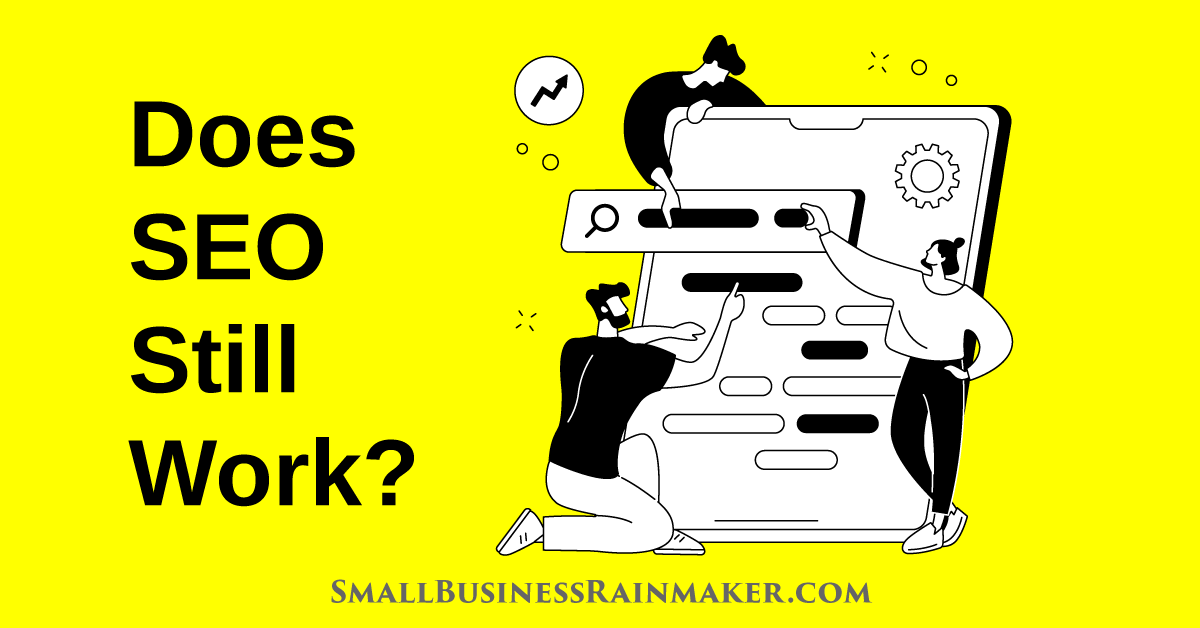



Leave a comment